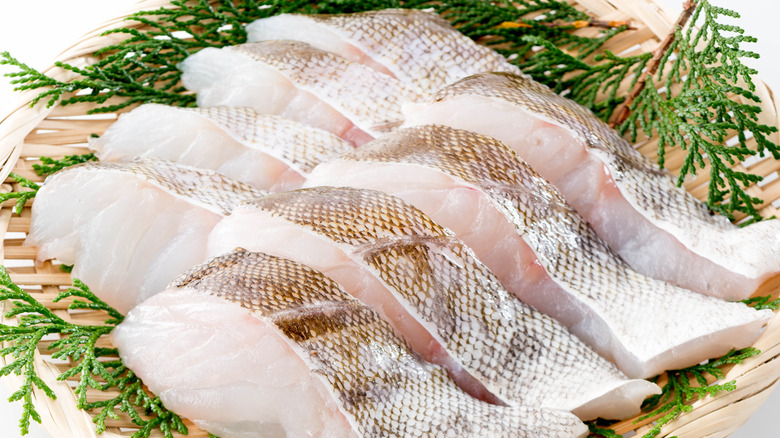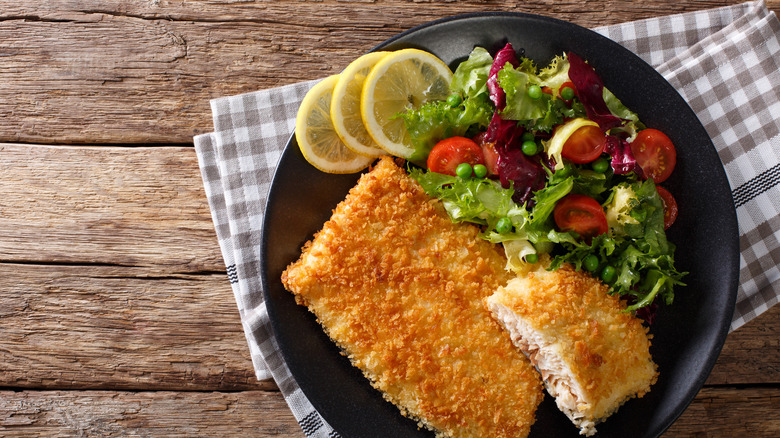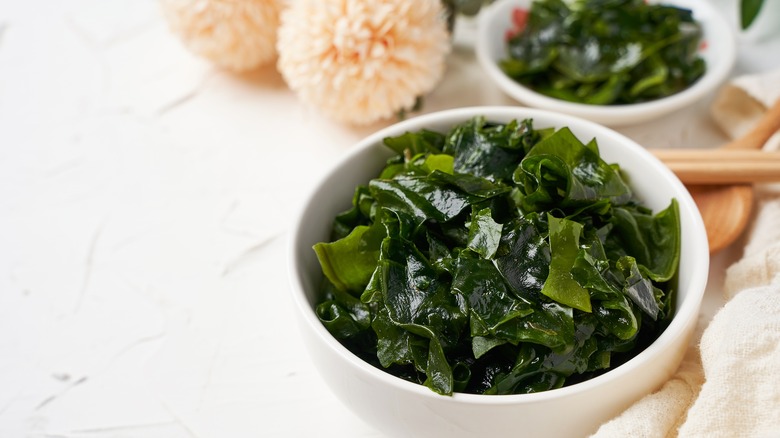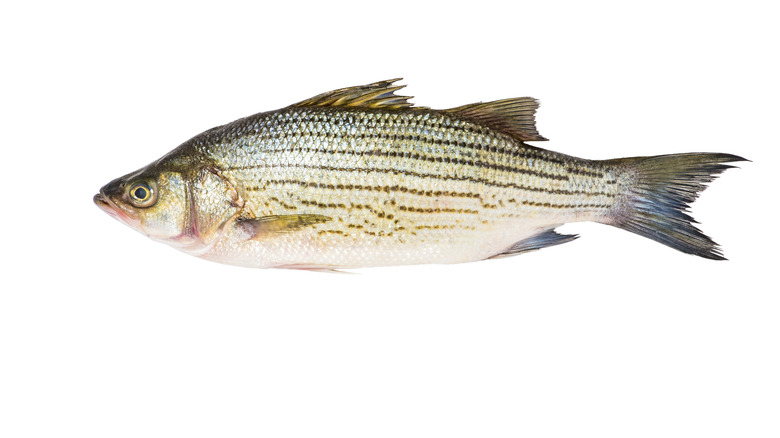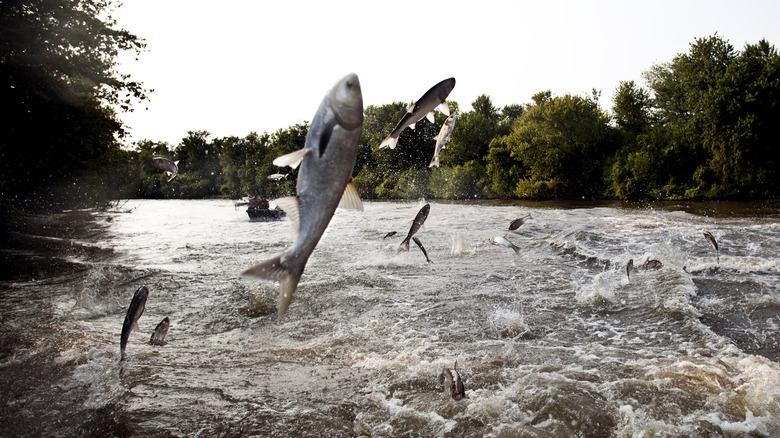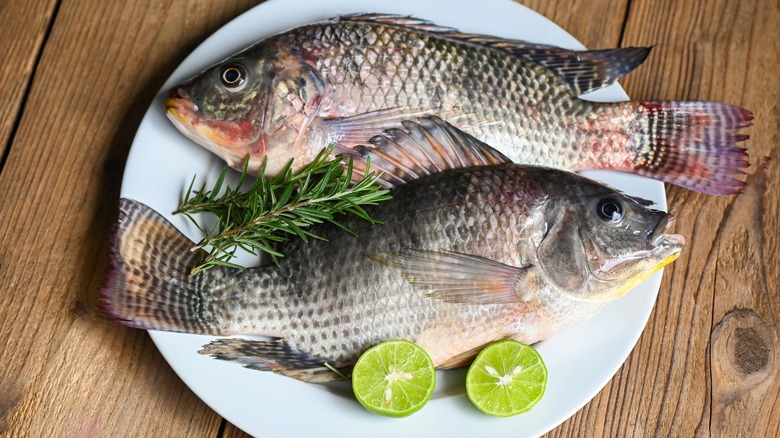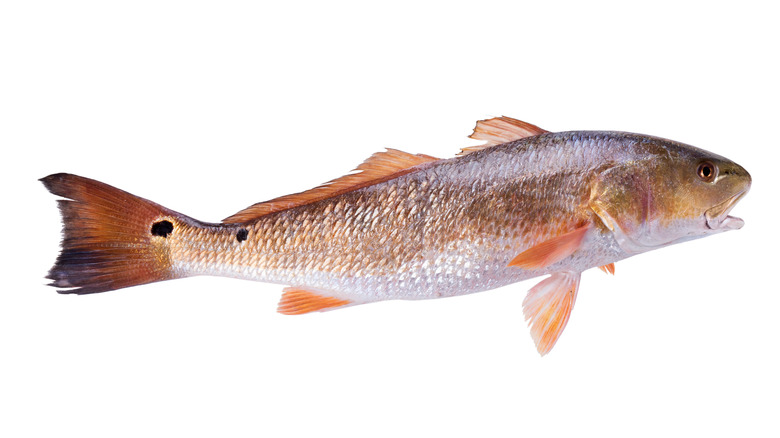20 Best Sustainable Seafood To Buy And Eat
Sustainable is one of the most popular buzzwords used in the modern climate and culinary lexicon. How do you decide what classifies a food or item as sustainable and if those measures justify purchasing it?
When it comes to most food items, sustainable is a classification that accrues a net-positive environmental benefit. This can mean that the food does not adversely contribute to habitat destruction, pollution, or excessive resource withdrawal. It can also mean that eating the food may help balance the population of another species, such as when eating invasive species. In terms of fishing and seafood, many experts examine how fish is caught, how farming contributes to pollution in an area, or if the population can reproduce sustainably, given the current population.
If you're shopping for sustainable seafood, the best preparation steps you can take to ensure your choices are the most ecologically-friendly options are to consult the Monterey Bay Aquarium's Seafood Watch Guide or a third-party certifier, such as the Marine Stewardship Council (MSC). Here are some of the most sustainable types of seafood you can select from your grocery store's seafood counter.
Pacific cod
The name cod alone is often seen as the antithesis of the sustainability movement. This is because most people are referring to Atlantic cod, which was devastated by overfishing in the 1980s and 1990s. Although this type of cod has not recovered to sufficient levels yet, the Pacific cod remains a much more sustainable option. Pacific cod is endemic to the Bering Sea, the Gulf of Alaska, the Aleutian Islands, and the Pacific coast. The National Oceanic and Atmospheric Administration (NOAA) has implemented significant management measures to control overfishing.
The main flavor difference between the two most common varieties of cod is that the Pacific cod is milder and more savory than its east coast comrade. Its firm flesh is perfect for grilling and baking.
Arctic char
Arctic char may not be the most popular fish item on the menu, but it is one of the most sustainable you can purchase from your local seafood purveyor. The Seafood Watch has the best sustainability rating for wild-caught fish from Canada's Cambridge Bay or farmed Atlantic Char from the United States, Canada, or Iceland. The Seafood Watch also recommends purchasing fish with the designated Aquaculture Stewardship Council (ASC) logo. Farmed varieties of these fish are raised in raceways and recirculating tanks, which limit wastewater and off-shore pollution.
Arctic char is an inexpensive salmon alternative you should try. Not only is it comparatively cheaper than salmon, but it provides similar levels of omega-3 fatty acids. You can bake, broil, or prepare the Arctic char in any way that you would cook salmon.
Farmed catfish
Farmed catfish is one of the most effective and successful farmed fish programs in the United States. Farmed catfish are grown in ponds in the southern United States, where the species has a very effective feed conversion rate (FCR). The channel catfish will grow by one pound with two pounds of feed, compared to a 1-to-7 ratio for beef and a 1-to-4 ratio for pork. This means that raising catfish requires very few inputs to produce body bass.
There are minimal differences between the famed and wild-caught catfish in flavor and texture, making buying this fish a relatively easy switch. In fact, wild-caught catfish tend to have a very muddy taste because of the environment where the fish is caught; the highly-regulated farmed fish environments tend to impart a more mild, sweet flavor on farmed catfish.
Nori, Wakame, and Kelp
It wouldn't be surprising to see a photosynthetic plant to be on a list of sustainable seafood items. Kelp, nori, and wakame, grouped into a class known as "macroalgae," growth is valued globally at over $6 billion. These macroalgae are grown for various uses besides wrapping sushi; they are also found in medicine, cosmetics, animal feed, and biofuel. These macroalgae are high in proteins, amino acids, antioxidants, and vitamins, making them a tasty and nutritional powerhouse.
Macroalgae are ecologically valuable because the algae absorb carbon dioxide and do not require any additional land, fertilizer, or freshwater to grow. In addition, the macroalgae will take up excess nutrients, like phosphorous and nitrogen, in the waterways, which can reduce nutrient pollution and runoff into waterways.
Anchovies
Anchovies — yuck or yum? It will likely depend on who you're asking. Regardless of if these tiny fish make you squeamish or not, they are one of the most sustainable and versatile types of fish you can eat. The northern anchovy has low bycatch, meaning the unintended catch species are limited, and the fishing methods used to catch the anchovies have a minimal environmental impact. The northern anchovy is also regulated under the Coastal Pelagic Fisheries Management Plan and monitored for landing data from year to year to ensure stocks are not being overfished. NOAA also governs the number of vessels in the fishery to avoid depleting the stocks.
You can make many dishes with anchovies, including baking them on a pizza or grinding them into a tapenade. Anchovies are also one of the more affordable options for seafood lovers — if you need another reason to eat more.
White shrimp
Shrimp and prawns tend to get a lot of pushback on the sustainability side of things. This is because the narrative of shrimp farming (aquaculture) focuses on the small numbers of poorly-regulated shrimp farms in Southeast Asia. If you want to get sustainable shrimp, your best bet is going to be to purchase wild-caught white shrimp.
The white shrimp, otherwise known as the common shrimp or the green shrimp, can be found in the Gulf of Mexico and the South Atlantic. Both of these stocks have historically not been overfished, and NOAA has been historically stringent over the levels of white shrimp in the regions to ensure that the stocks are not over-withdrawn. Fisheries must have special permits to harvest the white shrimp in federal waters, and NOAA will close the fishery if reserves dwindle due to low temperatures. This type of shrimp has an exceptionally clean taste and can be used for heavily-seasoned dishes like gumbo, shrimp boils, and Asian-style shrimp dishes.
Dungeness crab
The West Coast Dungeness crab has proven to be one of the most resilient crab species in the ecosystem. In recent years, fishermen on the west coast have caught almost all of the legal-sized male Dungeness crabs available, yet the population of the crab still remains stable or increases from year to year. This is because the male crabs can start reproducing early, and the female crabs can store sperm for more than a year — which means the crab can reproduce without males present. Current fishery regulations also require fishermen to return any female crabs back to the water to protect the population's numbers. The populations of crabs in central California have increased by five times as many crabs between 1970 and 2000, per NOAA.
The standard Dungeness crab is very meaty, weighing about two pounds and yielding 25% of its weight. Its sweet, nutty meat can be used in everything from melts to bisques and can be sold whole or picked meat.
Green crab
Invasive species — where the motto is "eat 'em to beat 'em." The green crab, or shore crab, is one of the most invasive species in North America. These crabs took a ride to the United States in the 1800s via European merchant ships. Since arriving, the population of the crab has expanded from the Eastern seaboard to the west coast and Alaska. The green crab has few natural predators and outcompetes local species for resources.
The green crab is a relatively small crab, so it cannot be eaten like a Dungeness crab. Instead, it can be boiled like a blue crab or other soft-shell crab varieties or used for seafood stock. Researchers at the University of Maine are also experimenting with a mechanical invention that would easily extract the meat from the crabs and refine it into a paste — kind of like surimi.
Farmed striped bass
The farmed striped bass is one of the Seafood Watch's top picks for sustainable seafood. These fish can be produced in recirculating aquaculture systems (RAS) within limited exposure to wild stocks, disease, or pollutants. The Seafood Watch lists wild-caught striped bass from the Northwest Atlantic (via pole-and-line) and Mexican marine net pens as "buy, but be wary of concerns." The open design of the net pens may lead to escaped fish, although there have been few escapes reported in the albeit small fishery. The pole-and-line fish from the United States is a slightly better option because the method reduces bycatch, and the stock is under continuous evaluation by NOAA and other regulating agencies.
Striped bass can be grilled or made into a striped bass crudo; its firm flesh lends well to acidic flavors and ingredients like fresh tomatoes, lemon juice, and white wine.
Skipjack tuna
Tuna has been historically associated with an over-extractive fishery. But some species of tuna are more sustainable than others. The Seafood Watch's best choices for skipjack tuna include trolling lines and pole-and-lines. These methods reduce the bycatch of species and have a minimal impact on the habitat of the skipjack. In addition, the Pacific Ocean fisheries where these fish are caught are well-managed and not overfished.
Skipjack tuna caught in the Indian Ocean, regardless of method, should be avoided because there is very little regulation of the catch size of these fish and very little oversight as to proper catching methods. The Seafood Watch also recommends avoiding purse seine nets because of the amount of bycatch associated — especially for species like manta rays and the over-harvested yellow tuna. The use of gillnets for catching skipjack is also prevalent in the Indian Ocean and should be avoided because the nets tend to entangle sharks, turtles, and other bycatch.
Asian carp or copi
Asian carp is another invasive species that has wreaked havoc on American freshwater ecosystems. Asian carp was renamed "copi " to help make the fish sound more appetizing and drum up consumer support for eating the fish. The fish, which was released into the United States in the 1960s and 1970s to control algae and plankton in treatment ponds, has grown out of control in recent years and spread northward up the Mississippi River. In these new environments, the carp emerge as the top predator and out-compete other species for resources and space.
Copi has a savory taste with firm, clean flesh. It can be boiled, steamed, pan-fried, roasted, or grilled. The consistency also lends itself well to burgers and fish cakes.
Nile tilapia
Nile tilapia is a humble type of fish that is both inexpensive and has a minimal environmental impact. Nile tilapia farmed in recirculating tanks are rated well by Seafood Watch because the fish tend to have low chemical use and have a low risk of disease transmission to outside waterways. Tilapia can also survive on a vegetarian diet, reducing dependence on wild-caught fishmeal.
Nile tilapia is unique because it has a very mild flavor that is indicative of the environment the fish was raised. This is why farmed fish from a reputable facility have a nuanced taste with minimal muddy notes. The Nile tilapia has been called the "aqua-chicken" because of how well it interacts with seasonings and diverse preparation methods, such as baking, grilling, searing, or curing.
Farmed bivalves
Bivalves are a class of seafood that use their filter-feeding capabilities to eat. As a result, the bivalves can improve water clarity and not rely on supplemental feed to grow. In addition, bivalves, which include clams, scallops, mussels, and oysters, have a very high nutrient density with a higher protein content than many terrestrial meats and a high concentration of micronutrients and minerals.
According to research performed by David Willer and David Aldridge, bivalves produce 11 tonnes of emissions per tonne of bivalve production. In comparison, cattle produce 340 tonnes of emissions per tonne of beef. Further research also indicates that if a quarter of the carnivorous fish aquaculture was replaced with bivalve production, it could potentially save 16.3 million tonnes of planet-warming carbon dioxide emissions.
Lionfish
Don't let their looks fool you; the lionfish is one of the most venomous fish on Earth. Their flashy appearance is one of the reasons why the fish proliferated in home aquariums before being dumped into the Gulf of Mexico, the Atlantic Ocean, and the Caribbean Sea. Since the species was released into the warm waters, it has reproduced, voraciously eaten up native fish species and crustaceans and permanently altered the ocean ecosystem.
Humans are one of the only creatures that can eat the lionfish and help control its population. Lionfish meat tastes buttery and soft, almost like a mahi mahi or a grouper filet. Although the fish has between 15 and 18 venomous spines, the flesh itself is safe to eat. It can be served as ceviche, breaded and baked, or cooked into a florentine.
Albacore tuna
Canned tuna is highly regarded for its affordability, but how sustainable is this protein? Albacore tuna is one of the predominant species used for canning; it has a relatively healthy population and is caught using methods with minimal environmental impact and bycatch rates. The best options are North Pacific and North Atlantic albacore tuna certified by the Marine Stewardship Council (MSC). Albacore caught in the Indian Ocean should be avoided, as the management schemes are not up-to-par with sustainable fisheries standards set by Seafood Watch.
Seafood Watch recommends purchasing canned tuna with pole-caught, pole-and-line-caught, troll-caught, fish aggregating device free (FAD-fee), free school, or school-caught on the label. Drifting longlines are a good option, but not the best, because they can catch more bycatch species like sharks and turtles.
Spiny dogfish
The spiny dogfish is a type of shark that is plentiful on the east coast. Currently, the Atlantic spiny dogfish is well-managed and has not indicated any signs of overfishing. In addition, management schemes of the spiny dogfish are careful to assess the current population of female dogfish, considering that the fish has one of the longest gestational periods of any fish species at nearly two years. In recent years, managers have also increased efforts to regulate the type of nets and trawls used to catch the dogfish to reduce incidental bycatch.
Most of the dogfish caught in America gets shipped overseas, where it is eaten in fish-and-chips or in stews. But there have been more and more pushes for Americans to eat dogfish and to support the American fisheries that catch the fish.
Sole
Sole is a flatfish with soft, white flesh perfect for grilling or baking. The most sustainable sole species include the Pacific sanddab, Dover sole, English sole, Petrale sole, and Rex sole. These species are excellent alternatives in both sustainability and flavor to flounder, which has populations in recovery from years of overfishing.
Since the sole is a bottom feeder, it must be caught via a bottom trawl rather than a pole-and-line. Managers have mitigated the risk of bycatch and habitat disruption caused by bottom trawling by implementing closed areas for marginal habitats and setting limits on the bycatch of at-risk species like halibut. Organizations like NOAA have also adopted policies like catch share programs, which allot shares to fishermen based on the health of the population, which can be bought and sold amongst the community without the stress of over-harvesting.
Red Drum
The red drum, or the redfish, spottail, or spotted bass, is sold frozen or fresh in filets and used for a variety of cooking purposes, including grilling, baking, and blackening. It is especially popular in Southeastern food cuisines where it is often served cooked "on the half shell" — where the fish is grilled with the skin still attached. This method maintains maximum flavor and moisture retention.
Although the red drum can be caught off the coast of the Atlantic Ocean, the most sustainable catch method Seafood Watch recommends is farmed. American aquaculture red drum fish operations are often situated on former shrimp farms and agricultural land, making it a sustainable use of land. The feed for these fish is sourced from sustainable fisheries and the environmental impacts of growing this fish are otherwise low.
Amberjack
Amberjack, also called Almaco Jack, can be a sustainable seafood option. Seafood Watch ranks Almaco Jack farmed in recirculating indoor tanks as a sustainable seafood option because the systems are typically effective at recycling wastewater and have a low risk of impacting wild stocks or spreading disease. Almaco jack farmed in off-shore net pens off the coast of the Eastern Central Pacific Ocean should be avoided because the pens risk transferring disease to wild populations and have a risk of escaping.
If you're purchasing wild-caught amberjack, you should purchase from the healthy South Atlantic rather than the overfished Gulf of Mexico. Although the Gulf of Mexico stock has shown signs of rebuilding since 2003. The gear to catch these wild-caught fish have minimal impacts on habitat.
Sablefish
Sablefish, or black cod, is a relatively sustainable seafood option with a delicious texture and flavor. The Seafood Watch recommends purchasing sablefish caught in the United States or Canada via pots, trawls, traps, and set longlines as the best options to reduce bycatch and maintain healthy sablefish stocks. Customers should also aim to purchase sablefish with a certified Marie Stewardship Council label.
You should be eating more sablefish because it has a less pertinent environmental impact than salmon or trout farming. This fish has low quantities of mercury and a relatively low impact on their surrounding environment. Sablefish is also a good choice for amateur cooks because it has a relatively high fat content, which makes the fish difficult to overcook. Sablefish can be pan-seared, baked, or made into ceviche.

